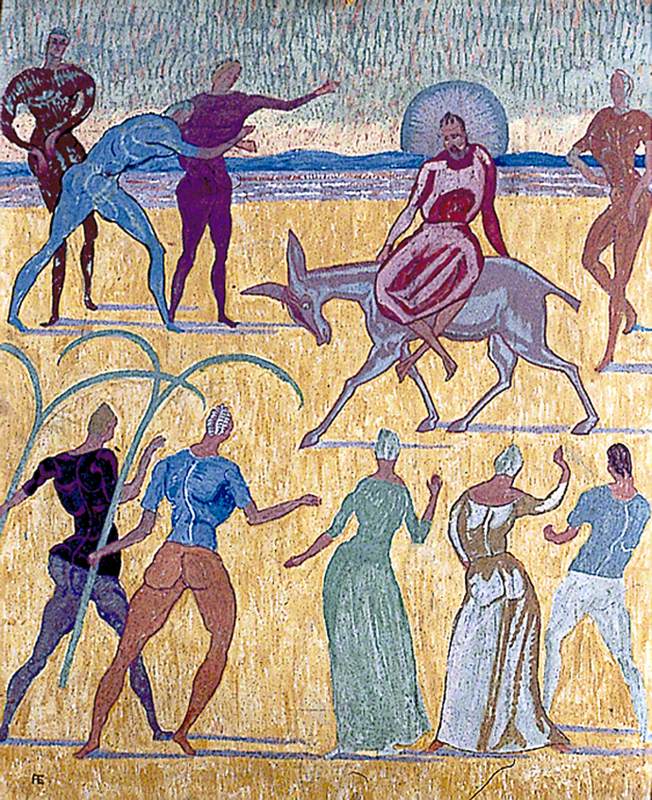Frederick Etchells was born at 63 Park Road, Newcastle upon Tyne, England on 14 September 1886 and studied architecture under Arthur Beresford Pite (1861-1934) and William Richard Lethaby (1857-1931) at the Royal College of Art in London from 1908 to 1911. After leaving the RCA, he switched his interest to art and lived on Paris and London. In Paris he had a studio and met Picasso and Modigliani. In London he became acquainted with Roger Fry (1866-1934) who was largely responsible for introducing him to Post-Impressionism. Etchells subsequently participated in Fry's Second Post-Impressionist Exhibition in 1912-13. Through Fry he met members of the Bloomsbury group and with them worked on the murals for the Borough Polytechnic in 1911 and by 1913. He was also employed by the Omega Workshops in London set up by Fry, Vanessa Bell and Duncan Grant.
Following a rift with Fry in October 1913, Etchells left his circle of artists and joined Wyndham Lewis' Rebel Art Centre, a Vorticist group. During his time with Lewis he contributed illustrations to Blast and also exhibited alongside Lewis, William Roberts and Edward Wadsworth with the Grafton Group and later with Group X and with the Arts League of Service. In 1913 Etchells was a founder member of the London Group but, like other Vorticists, left when Fry joined the Group.
Etchells served in World War One but was invalided out in 1917. He spent the rest of the war designing Canadian war memorials. Following the war, he again divided his time between London and Paris. In 1923, Etchells returned to architecture and in 1924 formed a partnership with Hugh MacDonald. The practice designed houses in London's Mayfair and Belgravia, banks and schools. In 1929-30 Etchells designed 232–234 High Holborn, London for the advertising firm Crawfords, a critically-acclaimed building that confirmed his modernist credentials. He subsequently designed a few small modernist houses.
Between 1926 and 1929 Etchells collaborated with George Pringle on a redevelopment scheme for Culcross Street in Mayfair, London and from 1929 to 1933 he was employed as principal architect to the Grosvenor Estate in Mayfair.
In the late 1930s and in the post--World War Two years, Etchells worked on a number of church restoration projects. This included the repair of churches that had suffered bomb-damage.
In 1924 Etchells and Hugh MacDonald founded Haslewood Books, a small private press that was active until 1931. During its short history, the press published 32 titles. Among artists who collaborated with the press were Thomas Lowinsky, Hester Sainsbury [Etchell's second wife], Edward Wadsworth, John Nash, Richard Wyndham, Gino Severini, and Edward McKnight Kauffer
Etchells also designed stained glass, an example of which can be seen at St. Mary's Church, Horsham, Sussex.
In 1927 Etchells translated Le Corbusier's 'Vers une architecture' as 'Towards a New Architecture'. The translation was influential in promoting awareness of Le Corbusier and his ideas in the English-speaking world.
Etchells died at his home in Folkestone, Kent on 16 August 1973.
A biographical file on Frederick Etchells is available on request at the Enquiry Desk, Royal Institute of British Architects Library, London.
Text source: Art History Research net (AHR net)













